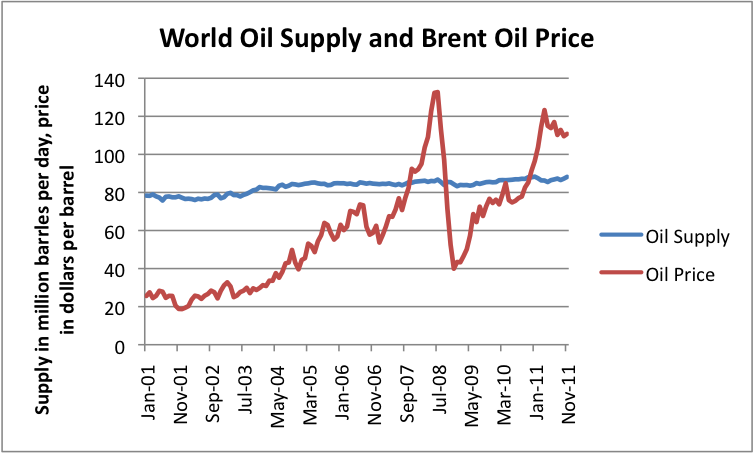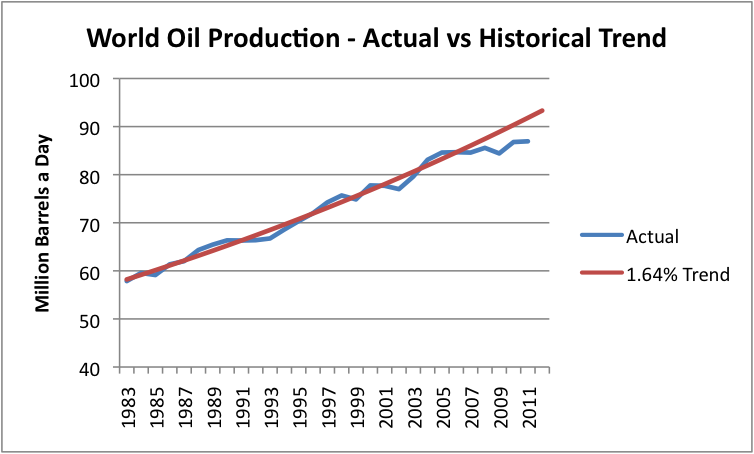Why Oil Prices Are so High: Production Shortfall, Iran Concerns, and Low Interest Rates
Gail Tverberg | Feb 26, 2012 01:47AM ET
Rising oil and gasoline prices are of concern to many people today. I see three basic issues involved:
- “Stalled out” growth in world oil supply
- Concerns about Iran
- Artificially low interest rates
In my view, the biggest contributor to high oil prices is the first one–stalled out oil supply. At this point, the interaction between oil demand and oil supply does not work in the way most people expect it would. Even if the price of oil rises, world oil production doesn’t increase by very much (Figure 1), if at all.

In the words of economists, world oil supply is relatively inelastic. This is true, even though the oil supply shown in Figure 1 is what is sometimes called “All Liquids,” so includes substitutes for crude oil, such as biofuels, natural gas liquids, “refinery gain,” and any fuels from coal-to-liquid and gas-to-liquid processes. These substitutes are not growing by enough to make up for the shortfall in crude oil growth.
If we compare recent oil production with that in the 1980s and 1990s, we see that about 2005, growth in world oil supply suddenly slowed down (Figure 2).

Between 1983 and 2005, world oil supply rose by 1.64% per year. If world oil supply had continued to rise at that rate, oil production would have been about 5 million barrels a day higher in 2011 than it actually was. The fact that oil production has remained relatively flat since 2005 is the primary reason oil prices have continued to rise, except during the 2008-2009 recession. (This recession was to a significant extent caused by high oil prices–I wrote an academic article on this subject, published in the journal Energy called, 17 million barrels a day of oil passes through the Straight of Hormuz, with 85% of these exports headed for Asian destinations. While other routes are available, there would be delays and higher costs involved. Even if the delays do not directly affect the US and the EU, there would likely be indirect impacts on world markets.
The world clearly cannot get along without 2.4 million barrels a day of exports from Iran, although perhaps losing only the EU portion of those exports (about 500,000 barrels a day) might be tolerable for a time. While some oil from Libya is coming back on line, oil prices are still very high. In a world where oil production is not rising by much, any loss of production is a problem because of the adverse impact high oil prices have on economies of oil importing countries, including those of the EU, Japan, and the United States. Any loss of production also leaves us more vulnerable to disruptions if another oil exporter suddenly has difficulties.
Low interest rates. Low interest rates should theoretically not directly affect oil prices, but if alternative forms of investment do not provide a reasonable yield, this fact may affect oil decisions as well. For example, if prices are trending upward, there may seem to be a premium for holding oil off the market. If interest rates are very low, this will make the comparison seem even better. Thus artificially low interest rates would seem to reinforce an upward oil price trend.
Furthermore, if artificially low interest rates actually induce businesses and individuals to invest in durable goods, production of these goods will require more oil, as well as other types of commodities. But we have already seen that oil supply does not really increase by much, even with large price increases. Thus, because of this effect, low interest rates will also act to increase oil prices, at least until recession (because of high oil prices) hits again.
Trading in financial instruments and/or cryptocurrencies involves high risks including the risk of losing some, or all, of your investment amount, and may not be suitable for all investors. Prices of cryptocurrencies are extremely volatile and may be affected by external factors such as financial, regulatory or political events. Trading on margin increases the financial risks.
Before deciding to trade in financial instrument or cryptocurrencies you should be fully informed of the risks and costs associated with trading the financial markets, carefully consider your investment objectives, level of experience, and risk appetite, and seek professional advice where needed.
Fusion Media would like to remind you that the data contained in this website is not necessarily real-time nor accurate. The data and prices on the website are not necessarily provided by any market or exchange, but may be provided by market makers, and so prices may not be accurate and may differ from the actual price at any given market, meaning prices are indicative and not appropriate for trading purposes. Fusion Media and any provider of the data contained in this website will not accept liability for any loss or damage as a result of your trading, or your reliance on the information contained within this website.
It is prohibited to use, store, reproduce, display, modify, transmit or distribute the data contained in this website without the explicit prior written permission of Fusion Media and/or the data provider. All intellectual property rights are reserved by the providers and/or the exchange providing the data contained in this website.
Fusion Media may be compensated by the advertisers that appear on the website, based on your interaction with the advertisements or advertisers.